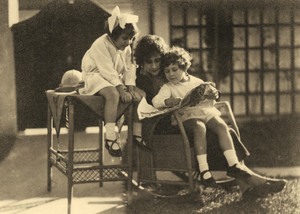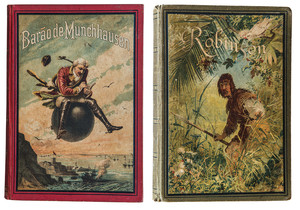
Photo Collection of the Paulista Museum at USP | Reproduction Hélio Nobre/José Rosael
Family scene from the 1920s: reading to children was a common habitPhoto Collection of the Paulista Museum at USP | Reproduction Hélio Nobre/José RosaelWhile investigating the production, distribution, and consumption of so-called “men’s books” (i.e., pornographic), Alessandra El Far, professor of anthropology at the Federal University of São Paulo (Unifesp) and author of the book Páginas de sensação [Sensational pages] (Companhia das Letras, 2004), noticed that “children’s books were also quite popular in Rio de Janeiro, thanks to the initiative of Pedro da Silva Quaresma, owner of Livraria do Povo bookstore, who published the collection known as the Children’s Library.”
The two sectors of the publishing industry were connected. Pimentel, who edited the collection of children’s books, became a figure of wide public renown after he authored the controversial O aborto [The abortion], released in 1893, an example of books aimed at men, likewise published by Quaresma. O aborto contained “many scenes of sex, lust, and obscenities, not recommended for women,” writes El Far. According to her, O aborto and A mulata [The mulatto woman]—the latter by Portuguese novelist Carlos Malheiro Dias (1875-1941), who also penned children’s books—sold more than 5,000 copies in just a few months, giving Quaresma enough financial wiggle room to invest in the children’s market. Around the same time, starting in 1860, the novels of José de Alencar and Machado de Assis began reaching bookstores, which were concentrated along Rua do Ouvidor and other streets in the vicinity of downtown Rio de Janeiro.

Reproductions Eduardo Cesar
European classics: Juca e Chico, translated by Olavo Bilac…Reproductions Eduardo CesarIn addition to seeking out new authors, publishers created ties to the growing school system, the government (which bought teaching material for students), and newspapers (which made immediate gains by selling advertising space for the books). “The press gradually assumed the role of ‘guarantor’ of the quality of educational books and authors, formerly endorsed basically through their connections to institutions like Colégio Pedro II high school and the Brazilian Historical and Geographical Institute,” wrote Alexandra Lima da Silva, professor with the Graduate Program in History at the Federal University of Mato Grosso (UFMT), in a paper that appeared in the Revista Brasileira da História da Educação in 2014. “Promotion was vital in the book trade, ranging from press advertisements paid for by publishers to pamphlets and excerpts printed on the backs of the books themselves,” she says.
Andréa Borges Leão, sociologist and professor at the Federal University of Ceará (UFC), studied the establishment and activities of Livraria Garnier bookstore and, in an article published in História da Educação in 2007, concluded: “I dismiss the hypothesis that the history of the French bookstore in Brazil was nothing but a colonialist initiative.” According to Leão, although editor Baptiste-Louis Garnier (1823-1893) was reputed to be a mercenary—so much so that the initials of his first name were said to stand for “Bom Ladrão” (good thief)—he played a decisive role in the production of children’s books in Brazil because he published translations of classic European works, such as the stories of Perrault and novels of Jules Verne, supplying not just the readers but also the future writers of ensuing Brazilian books.

Reproductions Eduardo Cesar
Aventuras pasmosas do celebérrimo barão de Münchhausen [The Surprising Adventures and Travels of Baron Munchausen], published in 1901; and Robinson Crusoe, published in 1884, the latter two translated by Carlos JansenReproductions Eduardo CesarPortuguese editor Francisco Alves (1848-1917), owner of the bookstore and publishing house of the same name—inherited from an uncle—also came out with translations, but he was known more for producing numerous school books and primers starting in 1860. Some of the titles were read both in school and at home, like Coração [Heart], by Edmundo De Amicis (1846-1908), a collection of heroic tales about boys from different regions of Italy, released in Milan in 1886. The book appeared in Rio in 1891, translated by Sergipe author João Ribeiro (1860-1934), a prominent teacher at Colégio Pedro II.
Intellectuals at that time also wrote books with a civic message, “aiming to instill moral and ethical values in children,” said Patrícia Hansen. “Books and readers were ascribed the role of social transformation.” In her doctoral dissertation, defended at USP in 2007, Hansen analyzed 18 textbooks, including América [America], published in 1897 and written by Rio Grande do Sul native Henrique Coelho Neto (1864-1934). He drew inspiration from Coração; Poesias infantis [Children’s poems], published in 1904 and written by Rio de Janeiro poet and journalist Olavo Bilac (1865-1918), who three years earlier had used the name Fantásio to sign his translation of Juca e Chico [Max and Moritz: A Story of Seven Boyish Pranks], released by Laemmert; and Saudade [Longing], one of the few titles to focus on life in the countryside, written by São Paulo historian and professor Tales de Andrade (1890-1977) and published in 1919, with a first run of 15,000 copies.
Read more: Lobato’s predecessors
Scientific articles
LEAO, A. B. A Livraria Garnier e a história dos livros infantis no Brasil – Gênese e formação de um campo literário (1858-1920). História da Educação. Vol. 1, pp. 159-84. 2007.
SILVA, A. L. da. A carne do mercado: Livros didáticos e o florescimento do comércio livreiro na cidade do Rio de Janeiro. Revista Brasileira de História da Educação. Vol. 14, pp. 223-49. 2014.
Book
EL FAR, A. Páginas de sensação [Sensational pages]. São Paulo: Companhia das Letras, 2004, 408 pp.